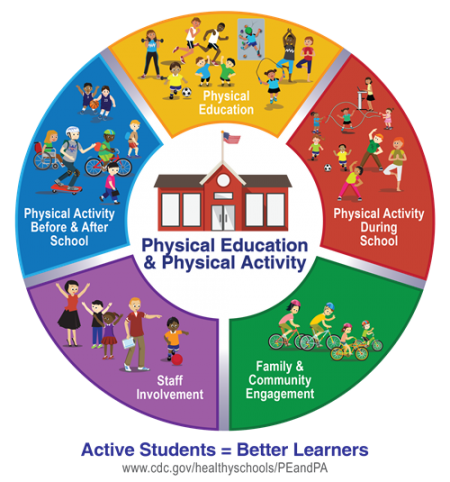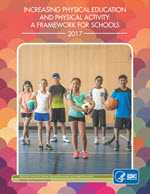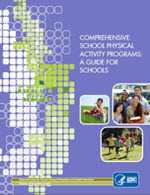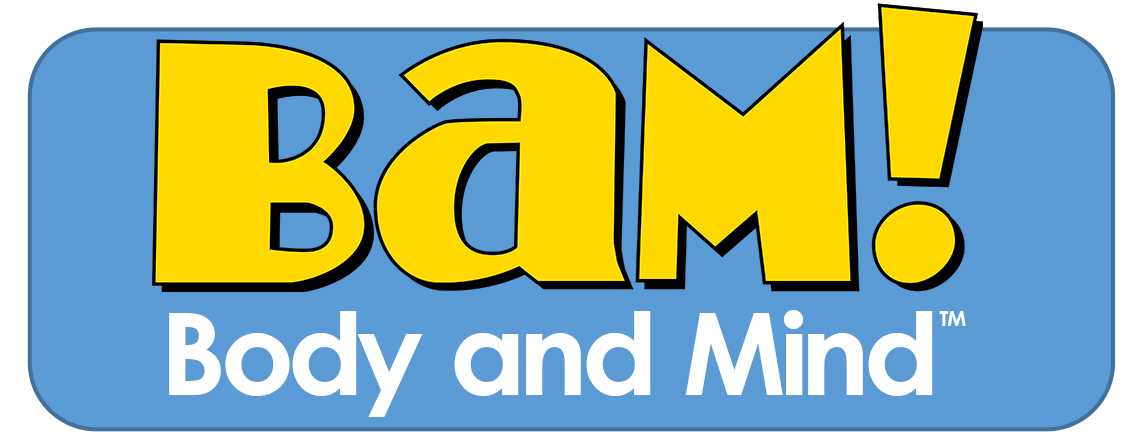Physical Education and Physical Activity
Overview
Schools are in a unique position to help students attain the nationally recommended 60 minutes of daily physical activity.1 Physical education and physical activity is one component of the Whole School, Whole Community, Whole Child (WSCC) model and can help shape lifelong physical activity behaviors.2
CDC recommends a multi-component approach by which school districts and schools use all available opportunities for students to be physically active, meet the nationally-recommended 60 minutes of physical activity each day, and develop the knowledge, skills, and confidence to be physically active for a lifetime.3–4 This approach is referred to as a Comprehensive School Physical Activity Program (CSPAP). The goal of CSPAP is to increase physical activity opportunities before, during, and after school and increase students’ overall physical activity and health.3–4

Figure 1. The 5 components of a Comprehensive School Physical Activity Program
PDF [PDF – 247 KB] | JPEG | PNG
A Framework for Schools

Comprehensive School Physical Activity Program Framework [PDF – 2 MB]
This document provides school health professionals, school administrators, physical education teachers, other school staff, and parents with detailed information on the components of a CSPAP framework. It identifies key professional development opportunities and resources to help schools implement the framework.
A Guide for Schools

Comprehensive School Physical Activity Program: A Guide for Schools [PDF – 6 MB]
CDC, in collaboration with SHAPE America, developed a step-by-step guide for schools and school districts to develop, implement, and evaluate comprehensive school physical activity programs. The guide can be read and used by an existing school health council or wellness committee, or by a new group or committee made up of physical education coordinators and teachers, classroom teachers, school administrators, recess supervisors, before- and after-school program supervisors, parents, and community members. It can be used to develop a new comprehensive school physical activity program or assess and improve an existing one.
eBook
Comprehensive School Physical Activity Program: A Guide for Schools [EPUB – 5 MB]
The eBook can be viewed on your iOS (iPad, iPhone, or iPod Touch) or Android device with an eReader. An eReader is an app that can display eBooks on your mobile device or tablet.
If you do not have an eReader app installed on your iOS (iPad, iPhone, or iPod Touch) device, search the App Store for an eReader, like iBooks. If you do not have an eReader app installed on your Android device, search the Google Play Store for an eReader. After an eReader app is installed on your device, you can download the eBook and open it on your device.
CSPAP e-Learning Course
The purpose of this module is to familiarize you with the components of a Comprehensive School Physical Activity Program and the process for developing, implementing, and evaluating one. After this module, you should be able to take the next steps to begin the process of developing a Comprehensive School Physical Activity Program.
The course objectives are for you to:
- Understand the importance and benefits of youth physical activity.
- Recognize the components of a Comprehensive School Physical Activity Program, and
- Learn the process for developing, implementing, and evaluating a Comprehensive School Physical Activity Program.
Resources
- CDC School Health Guidelines to Promote Healthy Eating and Physical Activity [PDF – 973 KB]
- CDC Comprehensive School Physical Activity Program: A Guide for Schools [PDF – 6 MB]
- CDC Tips for Teachers—Promoting Healthy Eating and Physical Activity in the Classroom [PDF-3.57MB]
- CDC School Health Index (online self-assessment and planning tool)
- Action for Healthy Kids resources
- Alliance for a Healthier Generation resources
- Let’s Move! Active Schools
- SHAPE America resources
- Voices for Healthy Kids resources
References
- Physical Activity Guidelines for Americans Midcourse Report Subcommittee of the President’s Council on Fitness, Sports & Nutrition. Physical Activity Guidelines for Americans Midcourse Report: Strategies to Increase Physical Activity Among Youth. Washington, DC: US Department of Health and Human Services, 2012.
- Association for Supervision and Curriculum Development (ASCD), Centers for Disease Control and Prevention. Whole School, Whole Child, Whole Community: A Collaborative Approach to Learning and Health 2014. Available at: http://www.ascd.org/ASCD/pdf/siteASCD/publications/wholechild/wscc-a-collaborative-approach.pdf [PDF – 2.24 MB].
- Centers for Disease Control and Prevention. School health guidelines to promote healthy eating and physical activity. MMWR. 2011;60(No. RR-5):28–33.
- Centers for Disease Control and Prevention. A Guide for Developing Comprehensive School Physical Activity Programs. Atlanta, GA: US Department of Health and Human Services; 2013.
- Page last reviewed: September 5, 2017
- Page last updated: September 5, 2017
- Content source:



 ShareCompartir
ShareCompartir